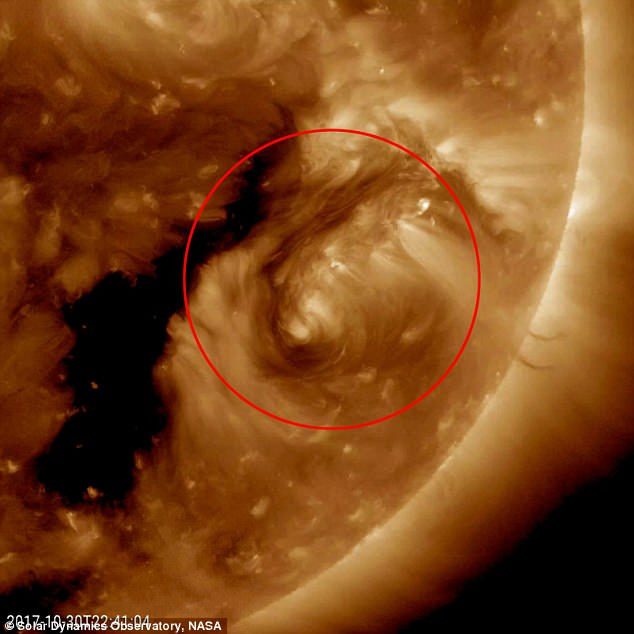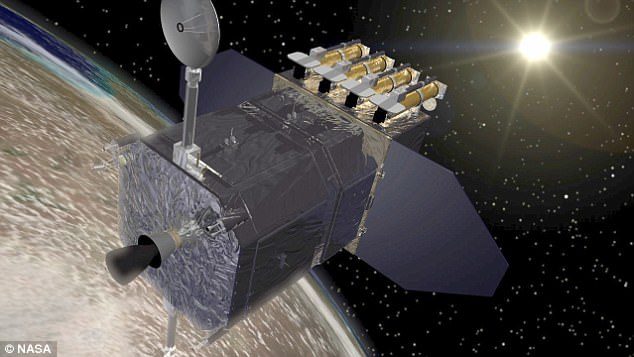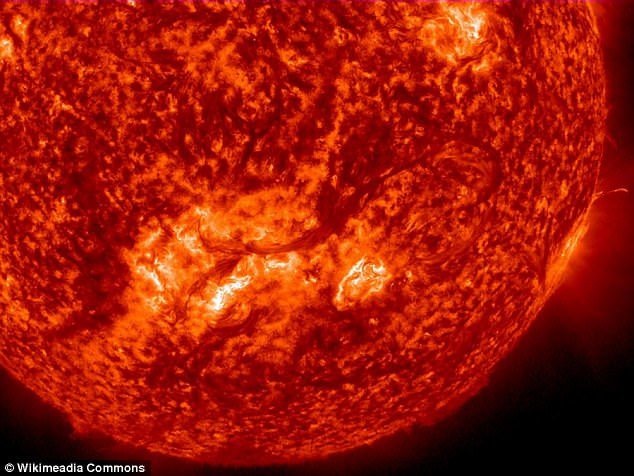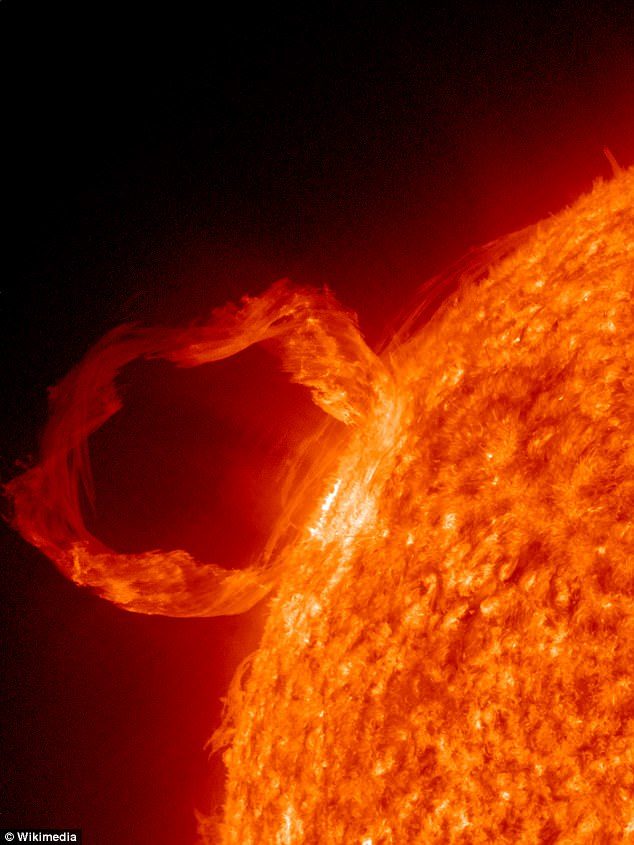
A dark snake-like filament can be seen erupting from the star, but while the formations are normally stretched out like a strand, this one is circular like a whirlpool.
This is because it is being yanked back by the star's staggering gravitational pull - which is about 27.9 times that of Earth.
The rare sight, captured by Nasa's orbiting Solar Dynamics Observatory (SDO), has only been seen a 'handful of times', the agency said.

SOLAR FILAMENTS
Solar filaments are clouds of charged particles that float above the sun, tethered to it by magnetic forces.
Solar filaments usually appear long and thin above the sun's chromosphere - the middle of its three layers.
Because they are cooler than their surroundings, the streams of charged particles often appear dark in images in which we are looking straight into the sun.
But if the strings are captured in images looking across the 'edge' of the sun, they appear brighter than the dark outer space behind them.
In this case scientists call them prominences instead of filaments.
The birth and death of filaments is a mystery and the subject of ongoing study by solar scientists.

'They are usually elongated and uneven strands. Only a handful of times before have we seen one shaped like a circle.
'While it may have no major scientific value, it is noteworthy because of its rarity.'
Comment: Say what?? It probably has scientific value because of it's rarity. We are entering the lowest solar minimum in at least 200 years meanwhile the behaviour of the planets in our solar system are changing, many are 'warming' up; our earth's magnetic field is weakening and we're bathing in more disruptive cosmic rays than ever before. There are some big unexpected shifts occurring in our solar system and we are witnessing some of those affects on the sun.
- Revision to 400-year sunspot record makes current solar cycle weakest in 200 years
- Solar minimum: The sun is getting quieter... and its rotation is slowing down
- As we approach solar minimum, cosmic ray flux continues upward trend
- What's Heating Up Io?
- Cosmic climate change: Is the cause of all this extreme weather to be found in outer space?
- Human mood & DNA changes with 19% increase in cosmic rays in Solar Cycle 25
- Mars Undergoing Global Warming
- Connecting the Dots: Cosmic Changes, Planetary Instability and Extreme Weather
The birth and death of filaments is driven by the sun's magnetic field.
Much about the formations remains a mystery, and scientists are unsure as to why some of them form as strands and others as circles.
The filament was spotted encircling an active region on the star's surface - an area with an especially strong magnetic field.
The black area to the left of the bright active region is a coronal hole, a magnetically open region of the sun.
The unusual filament entered the SDO's view from October 29 to 31, and the still was taken in a wavelength of extreme ultraviolet light to highlight the event.
Solar filaments usually appear long and thin above the sun's chromosphere - the middle of the star's three layers and the one most easily viewed by telescopes.
Because they are cooler than their surroundings, the streams of charged particles often appear dark in images in which we are looking straight at the sun.
But if the strings appear on images looking across the 'edge' of the star, they appear brighter than the dark outer space behind them.
The rare sight, captured by Nasa's orbiting Solar Dynamics Observatory (artist's impression), has only been seen a 'handful of times', the agency said
SOLAR DYNAMICS OBSERVATORY
The Solar Dynamics Observatory is a Nasa mission that has been observing the sun since 2010.
Its ultra-HD cameras convert different wavelengths of light into an image humans can see, and the light is then colourised into a rainbow of colours.
The satellite launched on February 11, 2010.
Comment: So these 'rare' occurrences and others like them may have begun a lot earlier than we think.
In this case scientists call them prominences instead of filaments.
Solar filaments normally last for a few weeks or months.
The gas in a filament will eventually move to a different layer in the sun and will no longer be visible in an image of the chromosphere.
But at the same time, other gas may move into the chromosphere and create a new filament somewhere else.
The birth and death of filaments is a mystery and the subject of ongoing study by solar scientists.
Because solar filaments are cooler than their surroundings, the streams of charged particles often appear dark (line in centre) in images in which we are looking straight at the sun
Another rounded filament was spotted by the SDO in March 2016, which took images every 12 seconds to create a video of the rare event.
In the clip, plasma is seen exploding from the surface only to be 'sucked' back in by the star's gravitational force.
This round solar filament attempts to break free, but curls and flows back towards the star.
If the string-like filaments are captured in images looking across the 'edge' of the sun, they appear brighter (pictured) than the dark outer space behind them




So it's like NASA then? It may have no major scientific value, but it's only one, so is noteworthy and often newsworthy, thanks to its curious statements and revelations.